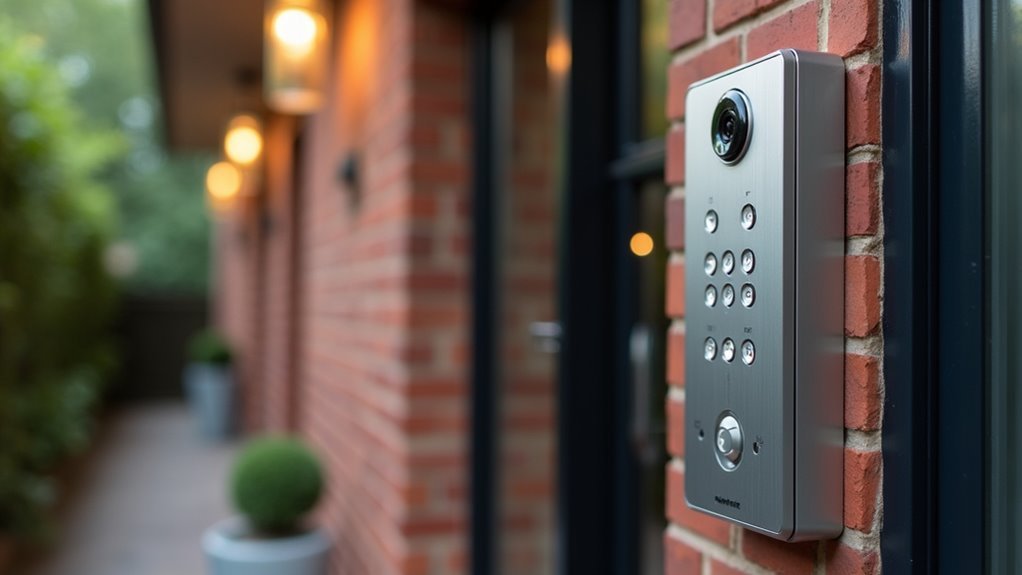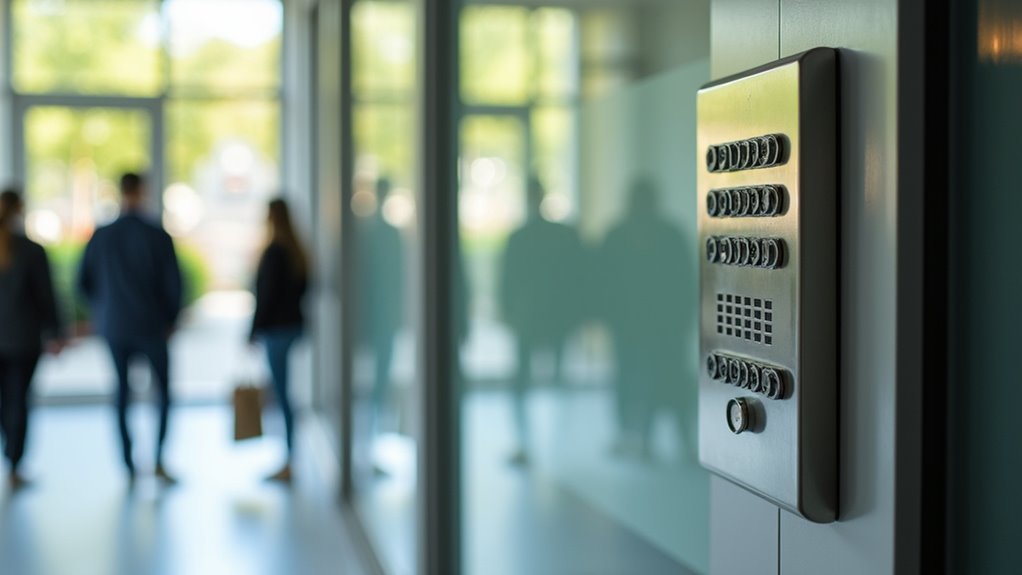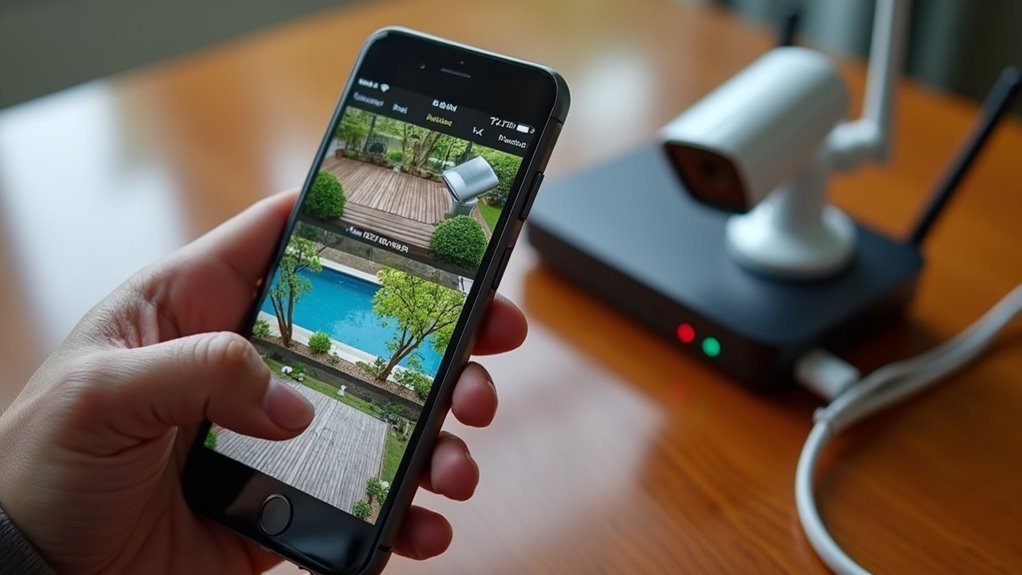You’ve probably experienced that frustrating moment when you’re expecting a delivery but can’t hear the buzzer from your third-floor apartment, or worse, when someone gains unauthorized access because residents blindly buzz in strangers. Modern apartment buildings face unique security and communication challenges that traditional single-family home doorbells simply can’t address. The solution isn’t just about convenience—it’s about creating an all-encompassing system that protects everyone while streamlining daily operations in ways you might not have considered.
Enhanced Security Features for Multi-Tenant Properties

When you’re managing a multi-tenant property, security becomes your top priority, and multi-family doorbells deliver extensive protection through advanced video verification systems.
These video doorbells allow residents to visually confirm visitors before granting access, greatly reducing unauthorized entry risks. You’ll benefit from sophisticated security systems that integrate recording capabilities, documenting every access event for monitoring and investigation purposes.
Multi-family video doorbells provide visual visitor verification and comprehensive recording capabilities, creating documented security protocols for enhanced unauthorized access prevention.
The remote access control features enable residents to open doors from their smartphones or units, streamlining entry management across multiple building points.
When you integrate these systems with existing smart home infrastructure, property managers gain enhanced oversight capabilities.
This thorough approach doesn’t just protect individual units—it creates a building-wide security network that monitors all entry points while providing residents with convenient, reliable control over their access requests and visitor management.
Real-Time Visitor Communication and Verification
Real-time visitor communication transforms how you manage property access by establishing immediate two-way dialogue between residents and visitors at entry points.
Video intercom systems let you see and speak with visitors through your smartphone or in-unit device, providing visual verification before granting access. This real-time communication eliminates guesswork about visitor identity and reduces security risks.
You’ll streamline visitor management by handling access requests efficiently from anywhere in your unit, cutting down wait times and improving tenant satisfaction.
Motion detection alerts keep you informed of door activity, while package notifications guarantee you’re aware of deliveries.
These features create an all-encompassing communication network that enhances both security and convenience, making visitor verification seamless and reliable for multi-tenant properties.
Remote Access Control and Door Management

Beyond real-time communication, remote access control puts door management directly in your hands through smartphone connectivity. You’ll open doors and gates from anywhere, eliminating the frustration of missed deliveries or service calls. Systems like ButterflyMX let you manage guest access remotely, reducing your physical presence at entry points.
| Traditional Entry | Multi-Family Doorbells |
|---|---|
| Missing deliveries | Never miss packages again |
| Waiting for guests | Grant instant remote access |
| Manual key exchanges | Digital access sharing |
| Limited security oversight | Real-time access monitoring |
| Service interruptions | Seamless provider entry |
Your smart locks integrate seamlessly with existing smart home systems, creating a cohesive living experience. This remote access control greatly streamlines visitor management while contributing to increased property value, as 64% of renters willingly pay more for enhanced security features.
Package Delivery Monitoring and Protection
You’ll receive instant notifications on your mobile device the moment packages arrive at your doorstep, eliminating the guesswork of delivery timing.
These real-time alerts work with integrated video monitoring to help you verify deliveries immediately and spot any suspicious activity around your packages.
With package theft affecting one in three Americans, you can’t afford to rely on outdated delivery management that leaves your parcels vulnerable.
Real-Time Package Alerts
When packages arrive at your multi-family building, modern doorbell systems instantly notify you through real-time package alerts, transforming how residents monitor and protect their deliveries.
You’ll receive immediate smartphone notifications the moment packages are detected, greatly reducing theft risks and ensuring you’re always aware of incoming deliveries.
Systems like ButterflyMX integrate sophisticated package detection technology that sends instant alerts directly to your device. You can visually monitor delivery events through video capabilities, creating a thorough log for tracking and verification purposes.
This enhanced security and access control functionality addresses the growing demand among renters, with 42% valuing remote monitoring capabilities.
These real-time package alerts don’t just improve your convenience—they substantially boost your multifamily properties’ overall value by enhancing security measures and streamlining property management efficiency.
Theft Prevention Measures
Package theft affects nearly 1 in 3 Americans, making robust theft prevention measures essential for multi-family properties.
Multi-family doorbells equipped with video capabilities let you monitor deliveries in real-time, greatly reducing theft likelihood. You’ll visually identify delivery personnel and confirm legitimate package drops, creating a powerful security deterrent.
Motion detection alerts notify you immediately when packages arrive, ensuring timely retrieval before thieves can strike.
Remote access features allow you to open doors for delivery personnel without being physically present, eliminating opportunities for criminals targeting unattended deliveries.
The recorded video footage serves as valuable evidence for law enforcement when theft incidents occur.
This thorough security approach protects your packages while fostering a safer living environment for all residents in your building.
Privacy Considerations for Shared Living Spaces

While video doorbells offer enhanced security for multifamily properties, they create complex privacy challenges that can expose property managers to significant legal risks.
Privacy concerns arise when cameras capture footage of shared hallways, lobbies, and common areas where residents expect reasonable privacy. You’ll face potential lawsuits if residents feel their movements are being monitored without proper consent or notification.
Unauthorized doorbell installations by residents compound these issues, creating surveillance disputes that burden your management staff. When multiple cameras operate in close quarters, tenants often feel uncomfortable with constant monitoring.
To protect yourself legally, you must establish clear recording zones that avoid capturing neighboring units and implement transparent data sharing policies.
Traditional intercom systems offer communication benefits without extensive surveillance, providing a privacy-conscious alternative for security-minded properties.
Types of Multi-Family Doorbell Systems Available
Property managers can choose from three primary doorbell system categories that each offer distinct advantages for multifamily buildings.
Wired multi-family doorbells provide stable connections but require extensive installation and higher upfront costs. You’ll need professional setup, but they deliver reliable performance without ongoing subscription fees.
Wired doorbells offer reliable, subscription-free performance despite requiring professional installation and higher initial investment costs.
Wireless systems offer easier installation through Wi-Fi or Bluetooth connectivity with minimal infrastructure disruption. You can integrate these with smart apartment features, though you might face ongoing cloud service costs.
Smart doorbells combine the best of both worlds, featuring video capabilities and smartphone compatibility.
These advanced intercom systems work seamlessly with mobile devices, allowing residents to verify visitors remotely and manage access control.
You’ll enhance security while providing modern convenience that today’s tenants expect.
Installation Requirements and Infrastructure Needs
When you’re planning a multi-family doorbell installation, you’ll need to decide between wired systems that require extensive cabling or wireless options that depend on strong Wi-Fi coverage throughout your building.
Your choice directly impacts power requirements, connectivity infrastructure, and the complexity of integrating the system with your property’s existing electrical setup.
You’ll also face unique building integration challenges that single-family installations don’t encounter, from maneuvering through shared spaces to ensuring consistent performance across multiple units.
Wired Vs Wireless Systems
Although selecting the right doorbell system for your multi-family property involves many considerations, the choice between wired and wireless systems fundamentally comes down to installation requirements and infrastructure needs.
Wired systems require extensive installation involving cabling and electrical work throughout your building’s infrastructure. You’ll face higher upfront costs due to professional installation requirements and materials, plus longer installation timeframes.
However, these systems operate independently without relying on internet connectivity.
Wireless systems offer easier installation with minimal structural disruption, making them ideal for retrofitting older buildings. You can often install them yourself, reducing initial costs and adding units without major infrastructure changes.
The trade-off? You’ll need reliable Wi-Fi coverage throughout your building to guarantee consistent functionality across all units.
Power and Connectivity Requirements
Before installing any multi-family doorbell system, you must evaluate your building’s power and connectivity infrastructure to guarantee reliable operation across all units.
Your power requirements depend heavily on the system type you choose. Wired systems need robust electrical infrastructure with dedicated circuits, while wireless doorbell options require reliable Wi-Fi coverage throughout your building.
Here’s what you’ll need to take into account:
- Dedicated electrical circuits for advanced systems requiring consistent power
- Battery backup solutions to maintain functionality during outages
- Strong Wi-Fi or Bluetooth connectivity reaching all entry points
- Integration compatibility with existing building electrical frameworks
- Weather-resistant components suited for your local climate conditions
Planning these connectivity and power elements upfront prevents costly modifications later and guarantees your tenants enjoy seamless communication with visitors.
Building Integration Challenges
Since multi-family buildings present unique structural and technological constraints, you’ll face several integration challenges that can greatly impact your doorbell system’s installation timeline and budget.
Your existing infrastructure plays a vital role in determining system compatibility. Wired systems often require extensive electrical work and professional installation services, driving up installation costs considerably compared to wireless alternatives.
However, wireless systems aren’t without challenges—they demand robust internet connectivity and strategic placement throughout your property.
Your property management strategy must account for scalability when selecting doorbell solutions. Future expansions or upgrades may necessitate additional infrastructure adaptations.
Consider your building’s electrical capacity, network capabilities, and physical layout before committing to any system. These factors directly influence both immediate expenses and long-term maintenance requirements for your multi-family doorbell investment.
Cost Analysis for Property Owners and Managers
When evaluating multi-family doorbell systems, you’ll find that the financial benefits extend far beyond the initial purchase price. A thorough cost analysis reveals multiple revenue streams and savings opportunities for property management.
Smart technology integration offers compelling financial advantages:
- Increased rental income – 64% of renters pay an extra $35.64 monthly for enhanced security features
- Reduced staffing costs – Streamlined visitor access minimizes on-site security personnel needs
- Lower insurance premiums – Decreased unauthorized access reduces liability claims and security breaches
- Reduced installation expenses – Integrated features eliminate separate access control system costs
- Improved tenant retention – Higher satisfaction rates reduce costly turnover expenses
The initial investment pays dividends through enhanced property value, operational efficiency, and tenant satisfaction, making multi-family doorbell systems a strategic financial decision.
Integration With Existing Building Security Systems
You’ll find that multi-family doorbells integrate effortlessly with your existing building security infrastructure through open APIs and standardized protocols.
This compatibility means you won’t need to overhaul your current systems—instead, you can enhance them with advanced visitor verification and centralized access control.
The seamless integration creates a unified security ecosystem that strengthens your property’s overall protection while simplifying management operations.
Seamless System Compatibility
Most modern multi-family doorbell systems offer exceptional compatibility with your building’s existing security infrastructure, eliminating the need for costly overhauls or complete system replacements.
Systems like ButterflyMX provide open API capabilities that seamlessly connect with your current technologies.
You’ll benefit from streamlined integration through:
- Wireless connectivity that utilizes existing Wi-Fi networks without extensive cabling requirements
- Smart home platform compatibility enabling unified property management through single app interfaces
- Video surveillance integration that enhances your overall security monitoring capabilities
- Electronic access control synchronization for thorough visitor management systems
- Reduced installation costs by leveraging current infrastructure investments
This compatibility transforms your property management efficiency while providing tenants with convenient, modern access solutions that work harmoniously with established security protocols.
Enhanced Security Features
While maintaining compatibility with existing infrastructure provides a solid foundation, modern multi-family doorbell systems elevate your property’s protection through advanced security features that integrate seamlessly with current building protocols.
You’ll streamline access control management while implementing enhanced security measures that work alongside your existing systems. Cloud-based integration enables real-time monitoring of visitor access, dramatically improving your response times to security incidents.
Video capabilities let residents verify visitors visually before granting entry, while smartphone functionality allows remote door access without physical presence.
You can log all access data for thorough security audits, helping you monitor entry patterns and identify potential breaches. This integration transforms your doorbell system into an all-encompassing security hub that actively protects your residents.
Tenant Satisfaction and Convenience Benefits
When you install multi-family doorbells in your property, you’re directly addressing one of tenants’ most valued conveniences: the ability to communicate with visitors without leaving their units.
This technology greatly boosts tenant satisfaction while streamlining daily interactions.
The convenience benefits of multi-family doorbells include:
Multi-family doorbells transform tenant experience by enabling seamless visitor communication, video verification, and remote access control from anywhere within residential units.
- Remote visitor communication from any unit location
- Video verification capabilities for enhanced security peace of mind
- One-touch remote access for guests and delivery personnel
- Reduced wait times through efficient visitor management systems
- Elimination of physical door answering requirements
Studies show 64% of renters will pay additional monthly fees for enhanced security features like video doorbells.
You’re not just installing technology—you’re investing in tenant retention and satisfaction.
The convenience factor alone makes multi-family doorbells a valuable amenity that modern renters actively seek.
Property Value Enhancement Through Smart Technology
Beyond tenant satisfaction, multi-family doorbell systems deliver considerable property value enhancement that directly impacts your bottom line. Smart technology like ButterflyMX transforms your property into a premium destination that commands higher rents and attracts quality tenants.
| Benefit | Impact | Value |
|---|---|---|
| Rental Premium | 64% willing to pay extra | $35.64/month |
| Tenant Retention | Lower turnover rates | Reduced vacancy costs |
| Market Position | Competitive advantage | Higher occupancy |
| Security Appeal | Enhanced safety features | Premium pricing justified |
| Tech Integration | Modern amenities | Increased property desirability |
Multifamily doorbells aren’t just convenience features—they’re strategic investments. Properties with advanced intercom systems experience notably lower tenant turnover, reducing costly vacancy periods. You’ll attract tech-savvy renters who value security and convenience, allowing you to justify premium pricing while maintaining high occupancy rates.
Maintenance and Management Considerations
You’ll need to evaluate system installation requirements before implementing multi-family doorbells, as proper infrastructure and wiring can greatly impact your initial investment.
Your ongoing operational costs will include subscription fees for cloud-based features, software updates, and technical support that keep the system running smoothly.
You must also consider how these doorbell systems will integrate with your existing building management infrastructure to avoid compatibility issues and maximize efficiency.
System Installation Requirements
Two distinct installation paths define multi-family doorbell system deployment, with wired systems demanding thorough infrastructure planning and wireless alternatives offering streamlined setup processes.
When evaluating system installation requirements, you’ll need to take into account several critical factors that impact both immediate setup and long-term functionality:
- Infrastructure assessment – Determine existing wiring capabilities and power supply availability
- Integration compatibility – Guarantee seamless connection with current security and access control systems
- Scalability planning – Design installations that accommodate future building expansions or tenant changes
- Maintenance considerations – Plan for ongoing software updates, battery replacements, and system troubleshooting
- Cost analysis – Factor in subscription fees, hardware upgrades, and potential replacement expenses
Your choice between wired and wireless systems will ultimately determine installation complexity, ongoing maintenance requirements, and scalability options for your property’s specific needs.
Ongoing Operational Costs
Five primary expense categories comprise the ongoing operational costs of multi-family doorbell systems, extending well beyond the initial installation investment.
You’ll face recurring software subscription fees for smart and video-enabled systems, which property management must budget annually. Regular maintenance becomes essential to guarantee peak functionality and security, increasing labor costs for your management teams.
Integration expenses arise when connecting doorbell systems with existing intercom and security infrastructure, often requiring compatibility upgrades. Scalability costs emerge as tenant numbers change, demanding system adaptations that impact future budgets.
Finally, you’ll need resources for resident training and user support, helping tenants effectively use complex doorbell features.
These ongoing operational costs require careful financial planning to maintain system effectiveness while managing your property’s bottom line efficiently.
Integration With Existing Infrastructure
Beyond budgeting for operational expenses, property managers must address the technical complexities of merging new doorbell systems with their building’s existing infrastructure.
Multi-family doorbells require careful compatibility assessments to guarantee seamless integration with current electrical, intercom, and security systems.
Key integration considerations include:
- Compatibility checks – Verify electrical systems, intercoms, and security setups work with new technology
- Wireless advantages – Choose wireless systems to minimize invasive installation procedures and renovations
- Network requirements – Assess Wi-Fi infrastructure capacity for reliable smart doorbell functionality
- Cloud-based management – Implement remote monitoring solutions like ButterflyMX for reduced maintenance burden
- Staff training – Educate property teams and residents on new system operation and features
Proper integration planning prevents costly retrofitting and promotes peak system performance.
Compliance With Building Codes and Regulations
When installing multi-family doorbell systems, you’ll need to navigate a complex landscape of building codes and regulations that vary by jurisdiction but share common safety and accessibility goals.
Your multifamily property must guarantee compliance with local mandates requiring secure access control systems that enhance tenant safety. These regulations typically demand intercom capabilities for reliable visitor communication and identity verification.
You’ll also need to meet ADA accessibility standards, incorporating visual alerts and audible signals for residents with disabilities.
If your jurisdiction requires video surveillance in residential buildings, you must balance security features with privacy law compliance.
Additionally, fire code requirements often mandate integration with building alarm systems, guaranteeing immediate emergency notifications reach all residents through your doorbell infrastructure.
Choosing the Right Multi-Family Doorbell Solution
With your regulatory requirements now clear, selecting the right doorbell system becomes your next priority.
Choosing the appropriate doorbell system requires strategic evaluation of your building’s unique operational and security requirements.
Multi-family doorbells require careful evaluation to confirm they meet your building’s specific needs while providing effective access management.
Consider these essential doorbell features when making your selection:
- Remote control capabilities – Systems like ButterflyMX offer mobile app integration for streamlined resident access
- Video verification – Visual confirmation enhances tenant safety by allowing identity verification before granting entry
- System integration – Compatibility with existing building management and security solutions guarantees seamless operation
- Installation flexibility – Wireless systems typically offer easier, more cost-effective installation than wired alternatives
- User-friendly scalability – Choose solutions that accommodate diverse residents and adapt to future tenant changes
Prioritizing these factors guarantees you’ll select a system that enhances security while simplifying daily operations.
Frequently Asked Questions
Why Don’t Apartments Allow Ring Doorbells?
You can’t install Ring doorbells because they create privacy concerns in shared spaces, potential legal liabilities for property management, and compliance issues since they record neighbors without consent in communal areas.
Is an Apartment Building a Multi Family Home?
You’re absolutely right that apartment buildings are multi-family homes. They’re designed to house multiple separate households within one structure, sharing common areas like entrances, hallways, and amenities unlike single-family homes.
What Is the Best Doorbell System for Apartments?
You’ll find ButterflyMX offers the best apartment doorbell system with cloud-based remote access through mobile apps. Swiftlane’s smart doorbells provide excellent video capabilities, while wireless options simplify installation for property managers.
Is Ring Security Good for Apartments?
Ring security isn’t ideal for apartments since you’ll face privacy concerns, legal liabilities from recording common areas, and potential tenant disputes. You’ll also deal with unauthorized installations and residents’ distrust over data-sharing practices.





Leave a Reply